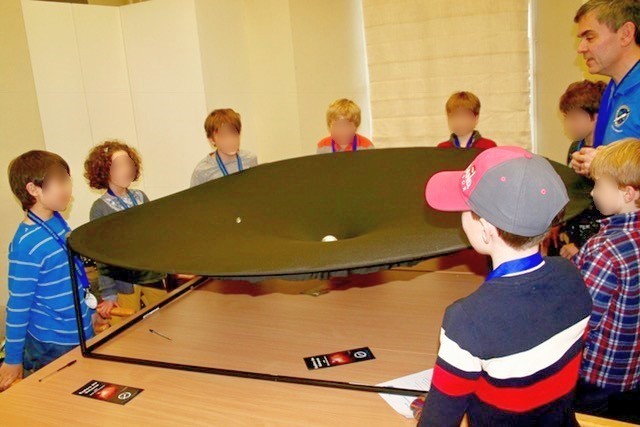Have you ever wanted to explain Gravity to a work colleague or the old man at the bus stop? If so then perhaps you’ve other things to resolve first. If not then perhaps you’ve a group of people that would enjoy exploring the how the paths of objects are influenced by spacetime; a school class, girls scouts, air cadets or women’s institute.
The Gravity Well is a simple experiment that is analagous to the way general relativity predicts spacetime is curved by mass i.e. how gravity works. You can build a simple one using a hulahoop, some stretchy fabric and some strong clips/pegs but here we supersize. The bigger experiments allow more people to see and get involved and allows more complicated behaviours to be simulated. The Hoop in this experiment is approximately 1.9m in diameter.
Things you’ll require:
- 2m length of Lycra(Spandex) fabric. It should be 4 way stretch and 1.5m wide. Black is the usual color. On ebay, you can pick this up for £10;
- 2 x 3m length collapsible carbon fibre tent polls. This by themselves were quite expensive but could be bought as part of a cheap Beach Tent on ebay for £12. The material left over was used to make a bag for the gravity well, a kite and a general purpose ground sheet;
- Sewing machine and thread or strong crocodile clips;
- An old boule/petanque ball. A solid metal ball about 8+cm in diameter;
Optionally – only required if free standing, else use 4 chair backs to prop up:
- 4 x 1.4m lengths of 20mm diameter plastic conduit;
- 4 x 0.4m lengths of 20mm diameter plastic conduit;
- 4 x corner connectors of 20mm diameter. I printed these as I couldn’t find in B&Q;
- 4 x hoop connectors of 20mm diameter. I printed these as better design than B&Q options.
Instructions:
- each of the tent poles is designed so that all but one section are identical and interconnect. You need to remove this odd section so that you can connect two poles together at each end to make a loop. Grab this odd section end of the pole and pull to stretch the inside bungee. Grab the bungee and allow the odd section to hang loose. This should expose the end of the bungee and allow you to cut/untie the end and remove the odd section of pole. Be careful not to let the bungee go else it will spring back and all the pole sections will fall apart. Temporarily tie a not in the bungee of the shortened tent pole to keep this from happening;
- repeat on the other tent pole to shorten by one section;
- neatly tie the bungees of the two poles together so that when the bungee pulls section together you are left with one long tent pole;
- connect the two ends of the new long tent pole together to form a hoop. It should be about 1.9m in diameter;
- temporarily clip the lycra on the hoop to remove any ruckles from the material to create a lightly taut drum. Note that 4-way lycra expands in different directions but by slightly different amounts, hence if you stretch the material using measurements alone, you’ll get a slightly elliptical hoop. For a circular hoop use a little trial and error clipping out and a tape measure to get an even diameter for the hoop. Mark on the lycra where the two ends of the pole meet;
- mark/pin a hem inside the hoop with the upper and tucked under lycra. With the hoop still in place, sew around to create a continuous pocket for hoop inside the material;
- cut off excess lycra and snip a small circular hole in the underside of the fabric where the ends of the pole meet. This will allow you to break the loop and carefully feed the pole out.
Using the Gravity Well:
- With no other objects on the lycra drum, you can demonstrate ‘flat’ spacetime doesn’t affect the motion of an object;
- With a small object in the middle, you can demonstrate small changes in the motion of a second object going past;
- With larger objects in the middle, you can demonstrate increasing warping of spacetime and stronger affects on motion;
- Demonstrate circular and elliptical orbits;
- Demonstrate multiple orbits and interaction/aggregation to form planets;
- Demonstrate the tendency to have a single direction of rotation in a solar system;
- Demonstrate a free return trajectory/figure 8 orbit using two stationery bodies on the drum and a small marble spacecraft.

